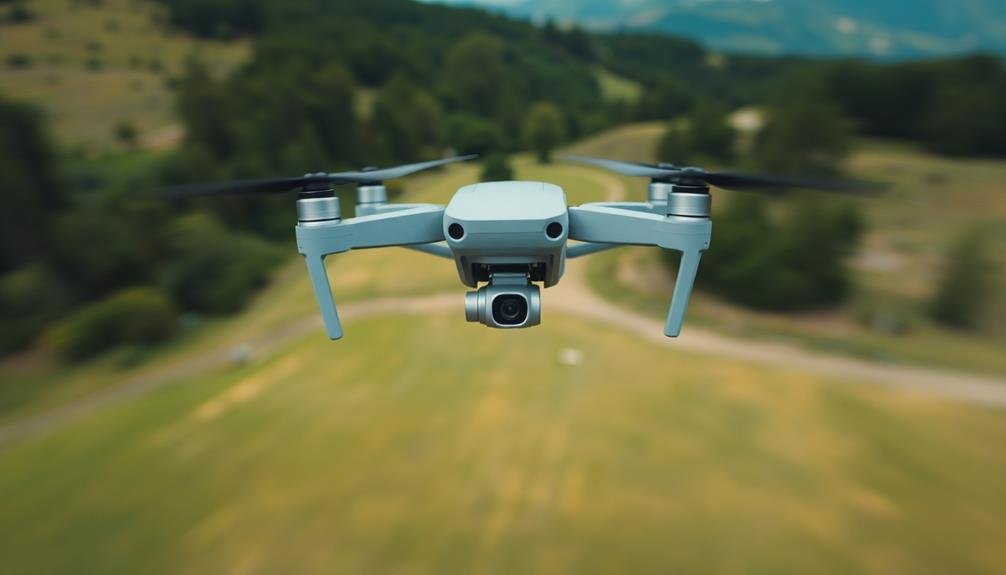To capture smooth barrel roll footage, you'll want to master three essential techniques. First, employ the circular motion technique, moving your camera in a consistent arc around your subject. Next, utilize gimbal stabilization to keep your shots level and steady throughout the roll. Finally, apply post-production smoothing tricks in editing software to polish your footage. These methods work together to create fluid, professional-looking barrel rolls that'll impress your audience. By combining precise camera movement, advanced stabilization technology, and clever editing techniques, you'll elevate your cinematography skills and produce stunning results. Dive deeper to reveal the full potential of these game-changing approaches.
Key Takeaways
- Employ circular motion technique, moving the camera in a consistent path around the subject.
- Use a motorized 3-axis gimbal set to follow mode for horizon stability during rolls.
- Apply post-production smoothing effects like warp stabilizer to reduce shakiness.
- Practice maintaining steady pace and proper positioning for optimal framing.
- Utilize keyframing and speed ramping in editing to enhance smoothness and polish.
Circular Motion Technique

Mastering the circular motion technique is essential for capturing smooth barrel roll footage. To execute this method, you'll need to move your camera in a circular path while maintaining a consistent distance from your subject.
Start by positioning yourself slightly to the side of your subject. As you begin recording, move around your subject in a circular motion, keeping the camera level and pointed at the center of your subject.
You'll want to maintain a steady pace throughout the entire rotation. It's vital to practice this movement until it becomes fluid and natural. Use your body's core to stabilize the camera, keeping your arms close to your torso for added support. If you're using a handheld camera, consider using a stabilizer or gimbal for smoother results.
For best results, try to complete the circular motion in about 3-5 seconds. This speed allows for a smooth barrel roll effect without making viewers dizzy. Remember to keep your subject centered in the frame throughout the movement.
If you're struggling with steadiness, try using visual markers on the ground to guide your path.
Gimbal Stabilization Method

Elevate your barrel roll footage with the gimbal stabilization method. This advanced technique uses a motorized gimbal to keep your camera level and steady throughout the roll.
First, mount your camera securely on a high-quality 3-axis gimbal. Verify it's properly balanced before you begin.
Set your gimbal to follow mode, allowing it to maintain horizon while you execute the barrel roll. As you start the maneuver, the gimbal will compensate for the aircraft's rotation, keeping your shot smooth and level.
You'll need to practice timing your roll with the gimbal's responsiveness for peak results.
For best performance, use a gimbal with high torque motors and adjustable parameters. Customize settings like follow speed and deadband to match your flying style and the specific requirements of barrel roll footage.
Don't forget to fine-tune your camera's settings, opting for a higher frame rate and shutter speed to capture crisp details during the fast-paced roll.
Post-Production Smoothing Tricks

While gimbal stabilization can work wonders in-flight, you'll often need to refine your barrel roll footage in post-production.
Start by applying a warp stabilizer effect to your footage in your editing software. This tool analyzes your clip and smooths out any remaining shakiness or jitters.
Next, use keyframing to manually adjust any sections that still look unsteady. Pay close attention to the horizon line and make sure it remains level throughout the roll.
You can also add a subtle rotation effect to enhance the smoothness of the barrel roll motion.
Color grading can help mask imperfections and create a more cohesive look. Apply a LUT (Look-Up Table) or adjust contrast, saturation, and exposure to draw attention away from any minor instabilities.
Consider using speed ramping techniques to slow down the footage slightly at the beginning and end of the roll, creating a more polished effect. This can help mask any abrupt changes.
Frequently Asked Questions
What Camera Settings Are Best for Capturing Barrel Roll Footage?
You'll want to use a fast shutter speed, around 1/1000s or higher, to freeze motion. Set your aperture wide open for more light, and increase ISO if needed. Use continuous autofocus and burst mode for sharp, action-packed shots.
How Do You Prevent Motion Sickness While Filming Barrel Rolls?
You'll want to focus on a fixed point during filming to reduce dizziness. Use a stabilizer, keep movements smooth, and take breaks between rolls. Don't forget to breathe steadily and stay hydrated throughout the process.
Are There Specific Lenses Recommended for Smoother Barrel Roll Shots?
You'll want to use wide-angle lenses for smoother barrel roll shots. They'll give you a broader field of view and minimize distortion. Try lenses between 16-35mm for best results. Don't forget to stabilize your camera too!
What Safety Precautions Should Be Taken When Filming Barrel Rolls?
When filming barrel rolls, you'll need to prioritize safety. Always secure your equipment tightly, wear proper restraints, and guarantee the pilot's certified for aerobatics. Don't forget to communicate clearly with the crew and have emergency procedures in place.
How Can You Maintain Focus During High-Speed Barrel Roll Maneuvers?
You'll need to use autofocus with subject tracking or pre-focus on a fixed point. Practice your eye tracking skills and anticipate the movement. Don't forget to stabilize your camera and use a fast shutter speed.
In Summary
You've now mastered three powerful techniques for capturing smooth barrel roll footage. Whether you're using circular motion, gimbal stabilization, or post-production smoothing, you'll be able to create stunning aerial shots that'll wow your audience. Don't be afraid to experiment with these methods and combine them for even better results. Remember, practice makes perfect, so get out there and start rolling! Your cinematic skills are about to take flight.

As educators and advocates for responsible drone use, we’re committed to sharing our knowledge and expertise with aspiring aerial photographers.




Leave a Reply